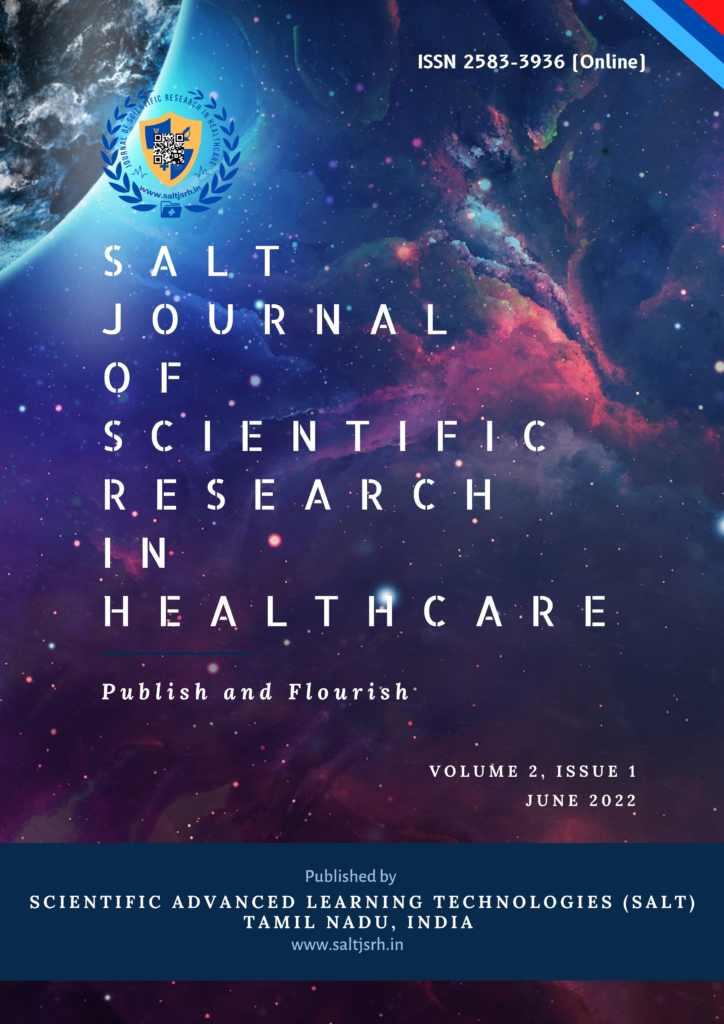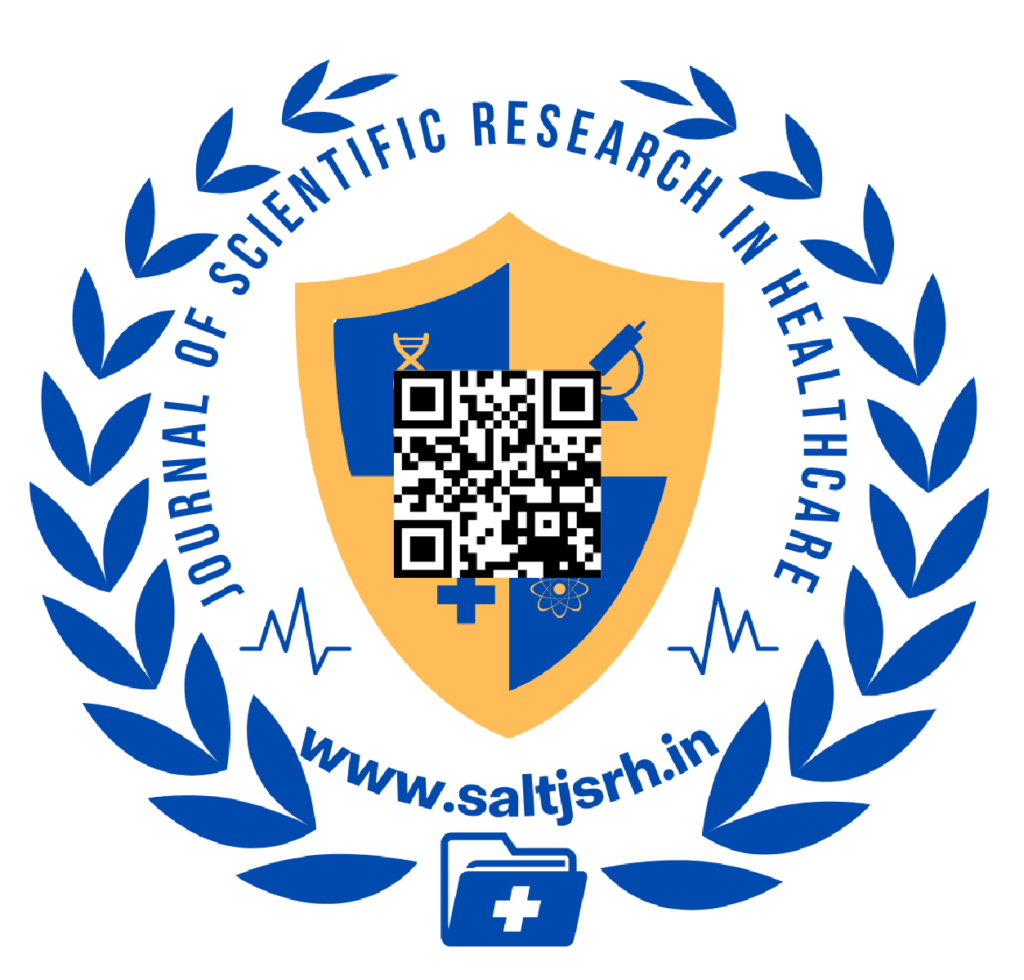EFFECTIVENESS OF ACTIVE RELEASE TECHNIQUES IN FROZEN SHOULDER -A REVIEW ARTICLE
SALT Journal of Scientific Research in Healthcare
Volume 2, Issue 1, Page 31-33, Published on 16th Feb 2022
https://doi.org/10.56735/saltjsrh.ms2202013133
Review Article
KM. DIVYA GANGWAR AND *RITA SHARMA
Department of Physiotherapy, SAHS, Sharda University, Greater Noida 201306, India
Corresponding Author: Rita Sharma, Assistant Professor, Department of Physiotherapy, SAHS, Sharda University, Greater Noida 201306, India.
ORCID ID: 0000-0002-3788-8977
Email : rita.sharma@sharda.ac.in
ABSTRACT
Frozen Shoulder (FS) is also known as adhesive capsulitis with unknown aetiology, which are specified by the limitation of both active, passive ROM is in the shoulder. It is most general cause of shoulder pain which effects between 2% to 5% of the common population and 10% to 20 % population with diabetes. FS is most generally looked at in women’s than in males between 40-60 years of age; in 20-30% of cases, it can be both sides. The Active release technique is a non-invasive soft tissue method that simultaneously finds and separates scar tissue. In our review article, mostly all studies reported the effectiveness of the active release technique in orthopaedic conditions, but more research is needed.
Keywords: Active Release Technique, Frozen Shoulder, Adhesive Capsulitis, Musculoskeletal Disorders
INTRODUCTION
Frozen Shoulder(FS) is also known as Adhesive Capsulitis with unknown aetiology, which are specified by the limitation of both active-passive ROM is in the shoulder. It is the most general cause of shoulder pain, affecting between 2% to 5% of the common population and 10% to 20 % of the population with diabetes. FS is most general looked at in women’s than in males between 40-60 years of age group; in 20-30% of cases, it can be both sides. It also determines that sleeping on affected is difficult because of severe pain and stiffness. Capsular contraction limits the range of motion and produces a capsular end feel. The extent of FS is divided into three steps: Freezing Phase (10-36 weeks), Adhesive Phase (4-12 months) and Resolution Phase (12-42).
The Active release technique is a non-invasive soft tissue method that simultaneously finds and separates scar tissue. The patient performs ART associate movement to release the adhesions through the tissue layers. Active release technique is a stack of treatments for examination, diagnosis and treatment of soft tissue disorders; it is also applied to relieve the nerves from the adjacent fascia, muscle, tendon. ART is a hands-on therapy for the recovery of flexible tissue function that includes the evacuation of the scar tissue, which can originate pain, rigidity, muscle tiredness, and abnormal impression, including disorder in the myofascial and soft tissue1.
METHODOLOGY
The database was searched through Google Scholar PubMed. Different keywords were used Active Release Technique, Frozen Shoulder., Adhesive capsulitis etc. Only those research articles were included in this article which has reported Active Release Technique use in orthopaedic conditions. Only the English language was included in this review article.
Application of active release technique in musculoskeletal conditions
Frozen Shoulder
The study conducted by Yatheendra Kumar G et al1 on effectiveness of ART and MET in Adhesive Capsulitis. The total duration of the study was thrice a week for five weeks. They concluded that ART and MET reveal the enhancement in VAS, ROM and SPADI in Frozen Shoulder; however, patients who were treated with Active Release Technique in addition to conventional treatment showed a more noticeable and quick improvement.
Tennis Elbow
Parth Trivedi et al2 conducted a study on“effectiveness of ART and myofascial therapy on pain, handgrip strength. In this study ART and MFR both were successful in decreasing pain, disability and improving Grip Strength in a patient with tennis elbow.” Myofascial Release was greater than the Active Release Technique in reducing pain and dysfunction and enhancing Grip strength.
Hamstring Tightness
Shraddha Kothwale et al3 investigated the advantage of ART and Positional Release Technique on hamstring tightness, and they concluded that ART (Active Release Technique) could be used as a productive, physiotherapeutic action in lower hamstring ‘tightness’ instability.
Superficial Trapezius
Golnaz Sadaria et al4 found that “both manual approaches of ART and MET lower the symptoms of LTrPs in the upper trapezius in both groups, with neither treatment being superior to the other”.
Plantar Fasciitis
Emad T. Ahmed et al5 did a study on Ultrasound Therapy and Active Release Technique versus Ultrasound alone in Plantar Fasciitis Management. They concluded that Other than established physiotherapy methods, the Active Release Approach is an excellent manual therapy technique that provides greater results than conventional therapy. It should be explored in the treatment of plantar fasciitis.
Upper Cross Syndrome
Dolphus Thacker et al. 6investigated “The use of ART and Prescribed exercises on Management of Upper Cross Syndrome”. They concluded that ART is superior to others.
Quadriceps
Janice M. Drover7 a Study conducted on the Impact of Active Release technique on quadriceps Inhibition and strength, and their study concluded that ART protocols did not lower obstruction and improved the power of athletes in ‘quadriceps muscles’, with frontal ache knee. Further analysis is needed.
Trigger Thumb
Scott Howitt DC et al8 conducted a study on conservative therapy using Graston therapy and Active Release Technique in Trigger Thumb, and they concluded that subject with trigger thumb shows improvement in dysfunction and pain after a management plan for Active release technique and “Graston therapy.
Carpal Tunnel Syndrome
James W George9 did a Pilot Study on the Active release technique’s impact on Patients suffering from Carpal Tunnel Syndrome, and the result indicates that the initial clinical pilot- appeal propose that ART might be productive for carpal tunnel syndrome subjects conservative management plan. Such outcomes reinforce the requirement for further clinical retrials with the huge sample.
CONCLUSION
In our review article, mostly all studies reported the effectiveness of the Active release technique in musculoskeletal disorders, i.e. frozen shoulder, plantar fasciitis, trigger thumb, upper crossed syndrome, hamstring tightness and trapezius pain. Active release technique shows notable improvements in pain, ROM, functional disability and quality of life in musculoskeletal disorders. There is a dearth of literature available that shows the effect of the active release technique in the frozen shoulder with large sample size, control group and follow up study. Hence there is a strong need felt to investigate the therapeutic efficacy of the active release technique in the frozen shoulder population.
REFERENCES
- Yatheendra Kumar G, Sudhakar S, Sudhan SG, Sivajyothi N, Senthil Selvam P, Deepthi KVSR. Effectiveness of active release technique and muscle energy technique in adhesive capsulitis. Int J Res Pharm Sci. 2017; 8(4), 693-698.
- Trivedi P, Sathiyavani D, Nambi G, Khuman R, Shah K, Bhatt P. Comparison of active release technique and myofascial release technique of pain, grip strength and functional performance in patients with chronic lateral epicondylitis. Int J Physiother Res. 2014; 2(3): 488-94.
- Shraddha Kothwale and Keerthi Rao. Effectiveness of positional release technique versus active release technique on hamstring tightness. Int J Physiother Res. 2018; 6(1): 2619-22.
- Sadria G, Hosseini M, Rezasoltani A, Akbarzadeh Bagheban A, Davari A, Seifolahi A. A comparison of the effect of the active release and muscle energy techniques on the latent trigger points of the upper trapezius. J Bodyw Mov Ther. 2017 Oct;21(4):920-925. https://doi.org/10.1016/j.jbmt.2016.10.005. Epub 2016 Oct 21. PMID: 29037649.
- Emad T Ahmed, Khaled Z Fouda. Active release technique and ultrasound therapy versus ultrasound alone in the management of planter fasciitis. Sylwan, 2022. 160(2).
- Dolphus Thacker, Jonathan Jameson, Jeremy Baker, Jordan Divine, Andrew Unfried. Management of upper cross syndrome through the use of Active Release Technique and prescribed exercises, Logan College of Chiropractic. 2011.
- Drover JM, Forand DR, Herzog W. Influence of active release technique on quadriceps inhibition and strength: a pilot study. J Manipulative Physiol Ther. 2004 Jul-Aug;27(6):408-13. https://doi.org/10.1016/j.jmpt.2004.05.006. PMID: 15319764.
- Howitt S, Wong J, Zabukovec S. The conservative treatment of Trigger thumb using Graston Techniques and Active Release Techniques. J Can Chiropr Assoc. 2006 Dec;50(4):249-54. PMID: 17549185; PMCID: PMC1864591.
- George JW, Tepe R, Busold D, Keuss S, Prather H, Skaggs CD. The effects of active release technique on carpal tunnel patients: A pilot study. J Chiropr Med. 2006 Winter;5(4):119-22. https://doi.org/10.1016/S0899-3467(07)60143-8. PMID: 19674682; PMCID: PMC2647071.
ARTICLE TYPE: Review Article;
ORCID ID: Open Researcher and Contributor Identifier (ORCID) ID of corresponding author: https://orcid.org/0000-0002-3788-8977;
ETHICAL: NA; ACKNOWLEDGEMENT: None;
FINANCIAL DISCLOSURE: The authors declare that there was no financial aid received.;
CONFLICT OF INTEREST: No conflict of interest associated with this research work.;
AUTHORS CONTRIBUTION: Conceptualization: KM. D.G., Writing and Supervision: R.S.,;
CORRESPONDING AUTHOR AFFILIATIONS: Ms. Rita Sharma, Assistant Professor, Department of Physiotherapy, Sharda University, Greater Noida 201306, India.;
CORRESPONDING AUTHOR EMAIL: rita.sharma@sharda.ac.in;
ARTICLE CITATION: Gangwar KD, Sharma R. Effectiveness of active release techniques in frozen shoulder – a review article. SALT J Sci Res Healthc. 2022 February 16; 2(1):31-33.
PUBLISHER’S NOTE: All claims expressed in this article are solely those of the authors and do not necessarily represent those of their affiliated organizations, or those of the publisher, the editors and the reviewers. Any product that may be evaluated in this article, or claim that may be made by its manufacturer, is not guaranteed or endorsed by the publisher.




© Km. Divya Gangwar and Rita Sharma.
Originally published in the SALT Journal of Scientific Research in Healthcare (https://saltjsrh.in/), 16.02.2022.
This is an open-access article distributed under the terms of the Creative Commons License (https://creativecommons.org/licenses/by-nc-nd/4.0/), which permits unrestricted use, distribution, and reproduction in any medium, provided the original work, first published in the SALT Journal of Scientific Research in Healthcare (https://saltjsrh.in/), is properly cited. The complete bibliographic information, a link to the original publication on https://saltjsrh.in/, as well as this copyright and license information must be included.
